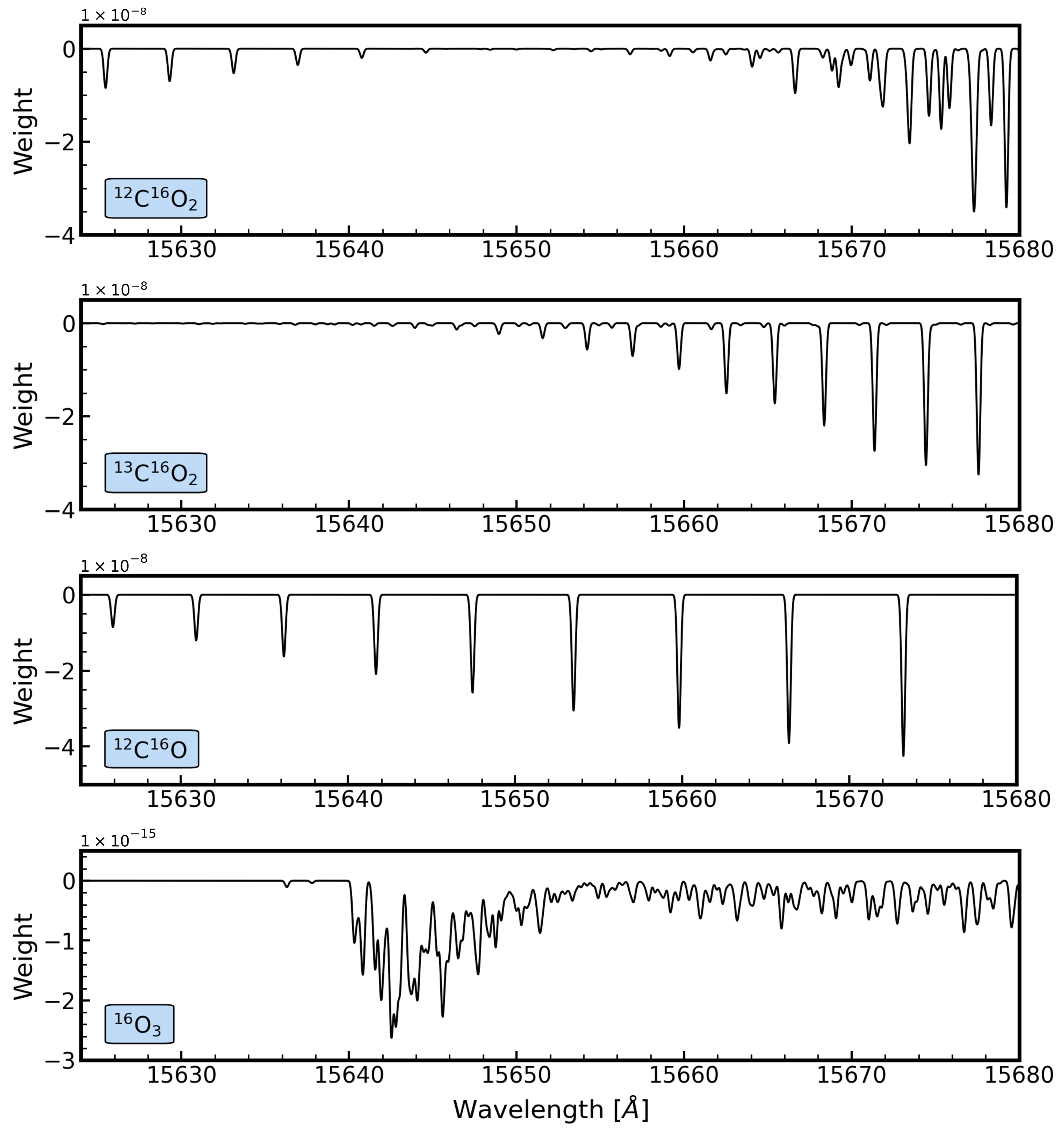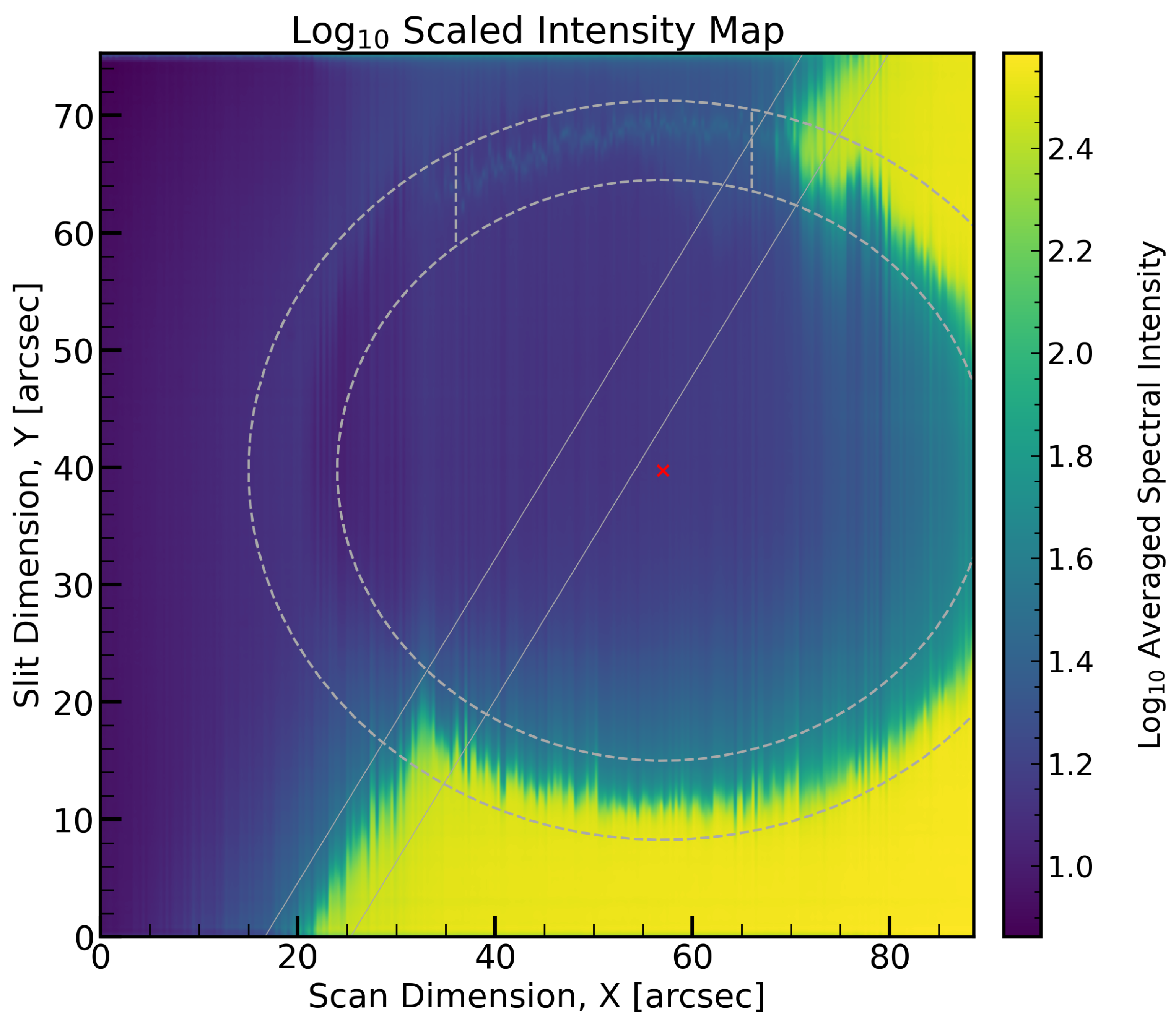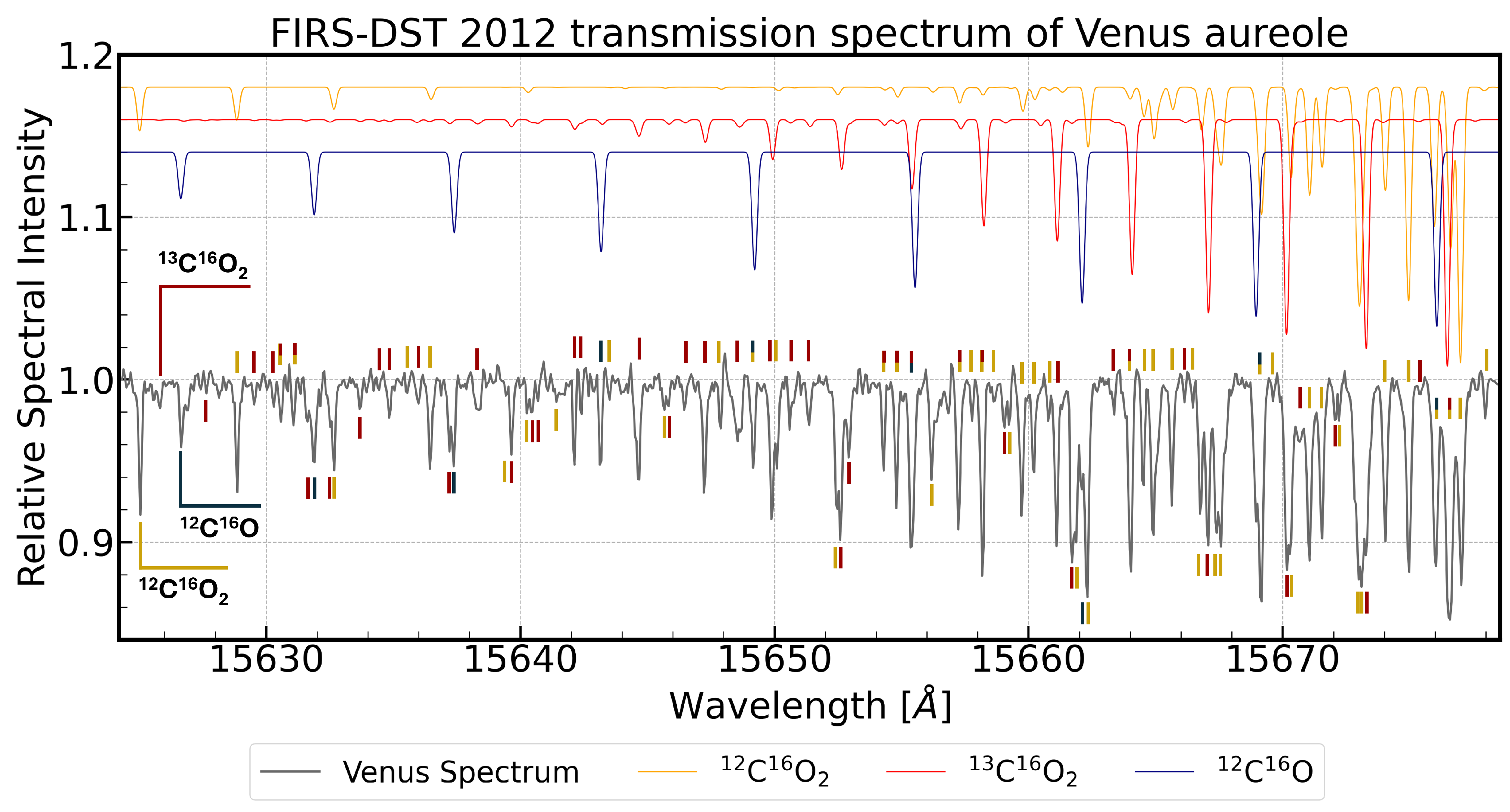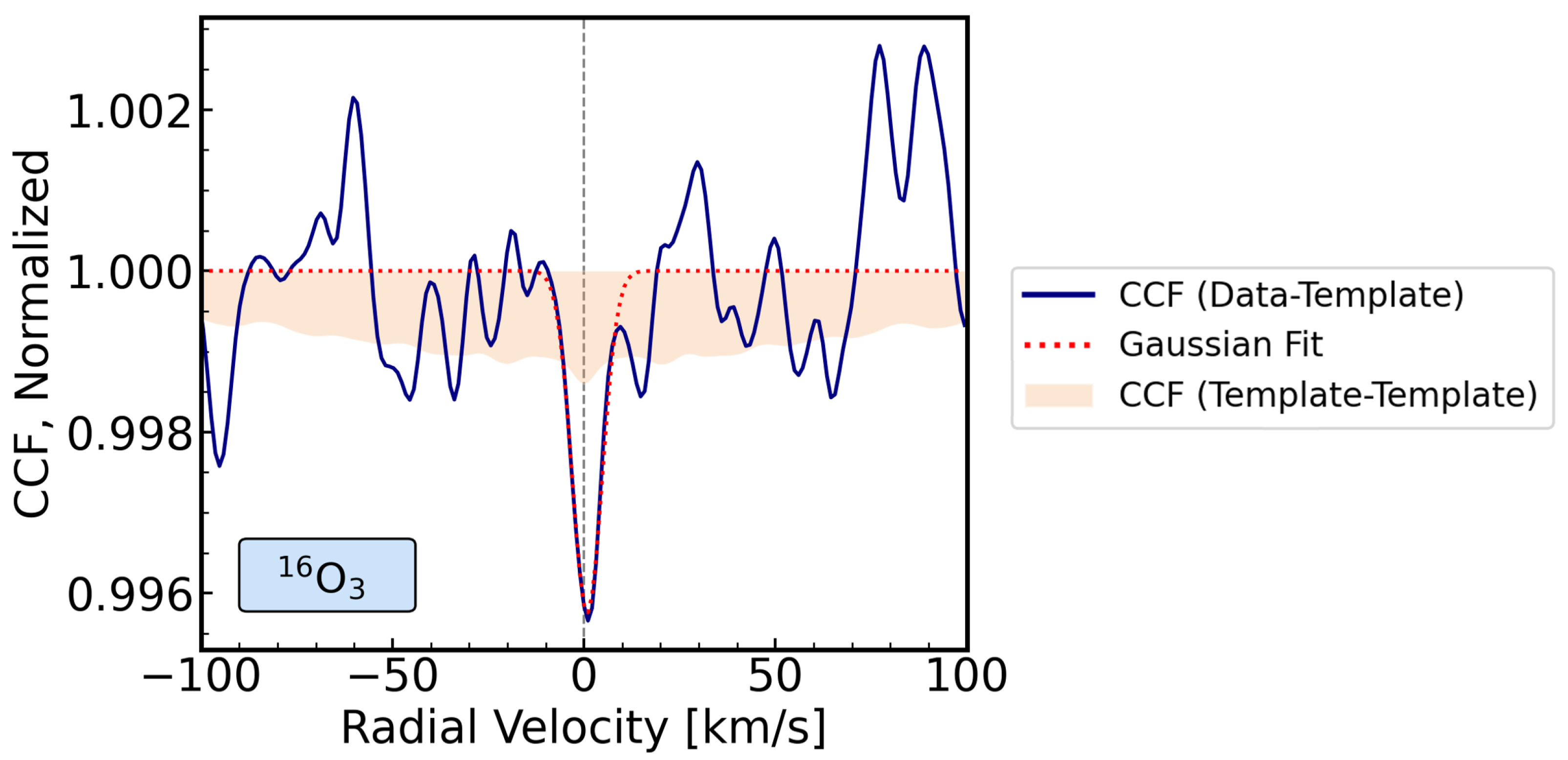Transmission Spectroscopy Along the Transit of Venus: A Proxy for Exoplanets Atmospheric Characterization
Abstract
:1. Introduction
2. Observations
3. Methodology
3.1. Transmission Spectrum Extraction
3.2. Atmospheric Transmission Models
3.3. Cross-Correlation Analysis
4. Results and Discussion
4.1. Planetary Transmission Spectrum
4.2. Cross-Correlation Analysis
5. Conclusions
Author Contributions
Funding
Institutional Review Board Statement
Informed Consent Statement
Data Availability Statement
Acknowledgments
Conflicts of Interest
Abbreviations
| NIR | Near-Infrared |
| FIRS | Facility Infrared Spectropolarimeter |
| DST | Dunn Solar Telescope |
| ELT | Extremely Large Telescope |
| ARIEL | Atmospheric Remote-sensing Infrared Exoplanet Large-survey |
| HITRAN | High-Resolution Transmission Molecular Absorption Database |
| VIRA | Venus International Reference Atmosphere |
| DACE | Data Analysis Centre for Exoplanets |
| CCF | Cross-Correlation Function |
| RV | Radial Velocity |
| FWHM | Full Width at Half Maximum |
| SPICAV | Spectroscopy for Investigation of Characteristics of the Atmosphere of Venus |
| SOIR | Solar Occultation at Infrared |
Appendix A

References
- William, S.; Sanjay, S. Venus, 1st ed.; Reaktion Books: London, UK, 2022; pp. 44–61. [Google Scholar]
- Ehrenreich, D.; Vidal-Madjar, A.; Widemann, T.; Gronoff, G.; Tanga, P.; Barthélemy, M.; Lilensten, J.; Lecavelier Des Etangs, A.; Arnold, L. Transmission spectrum of Venus as a transiting exoplanet. Astron. Astrophys. 2012, 537, L2. [Google Scholar] [CrossRef]
- Reale, F.; Gambino, A.; Micela, G.; Maggio, A.; Widemann, T.; Piccioni, G. Using the transit of Venus to probe the upper planetary atmosphere. Nat. Commun. 2015, 6, 7563. [Google Scholar] [CrossRef] [PubMed]
- Azevedo Silva, T.; Demangeon, O.; Santos, N.; Allart, R.; Borsa, F.; Cristo, E.; Esparza-Borges, E.; Seidel, J.; Palle, E.; Sousa, S.; et al. Detection of barium in the atmospheres of the ultra-hot gas giants WASP-76b and WASP-121b. Together with new detections of Co and Sr+ on WASP-121b. Astron. Astrophys. 2022, 666, L10. [Google Scholar] [CrossRef]
- Snellen, I.; de Kok, R.; de Mooij, E.; Albrecht, S. The orbital motion, absolute mass and high-altitude winds of exoplanet HD209458b. Nature 2010, 465, 1049–1051. [Google Scholar] [CrossRef] [PubMed]
- Seidel, J.; Prinoth, B.; Knudstrup, E.; Hoeijmakers, H.; Zanazzi, J.; Albrecht, S. Detection of atmospheric species and dynamics in the bloated hot Jupiter WASP-172 b with ESPRESSO. Astron. Astrophys. 2023, 678, A150. [Google Scholar] [CrossRef]
- Madhusudhan, N.; Sarkar, S.; Constantinou, S.; Holmberg, M.; Piette, A.; Moses, J. Carbon-bearing Molecules in a Possible Hycean Atmosphere. Astrophys. J. Lett. 2023, 956, L13. [Google Scholar] [CrossRef]
- Lustig-Yaeger, J.; Meadows, V.; Lincowski, A. The Detectability and Characterization of the TRAPPIST-1 Exoplanet Atmospheres with JWST. Astron. J. 2019, 158, 27. [Google Scholar] [CrossRef]
- Ehrenreich, D.; Tinetti, G.; Lecavelier Des Etangs, A.; Vidal-Madjar, A.; Selsis, F. The transmission spectrum of Earth-size transiting planets. Astron. Astrophys. 2006, 448, 379–393. [Google Scholar] [CrossRef]
- Kane, S.; Barclay, T.; Gelino, D. A potential super-Venus in the Kepler-69 System. Astrophys. J. Lett. 2013, 770, L20. [Google Scholar] [CrossRef]
- Hedelt, P.; Alonso, R.; Brown, T.; Collados Vera, M.; Rauer, H.; Schleicher, H.; Schmidt, W.; Schreier, F.; Titz, R. Venus transit 2004: Illustrating the capability of exoplanet transmission spectroscopy. Astron. Astrophys. 2011, 533, A136. [Google Scholar] [CrossRef]
- Lincowski, A.; Meadows, V.; Crisp, D.; Robinson, T.; Luger, R.; Lustig-Yaeger, J.; Arney, G. Evolved Climates and Observational Discriminants for the TRAPPIST-1 Planetary System. Astrophys. J. 2018, 867, 76. [Google Scholar] [CrossRef]
- Pasachoff, J.; Schneider, G.; Widemann, T. High-resolution satellite imaging of the 2004 transit of Venus and asymmetries in the cytherean atmosphere. Astron. J. 2011, 141, 112. [Google Scholar] [CrossRef]
- Tanga, P.; Widemann, T.; Sicardy, B.; Pasachoff, J.; Arnaud, J.; Comolli, L.; Rondi, A.; Rondi, S.; Sütterlin, P. Sunlight refraction in the mesosphere of Venus during the transit on June 8th, 2004. Icarus 2012, 218, 207–219. [Google Scholar] [CrossRef]
- Pere, C.; Tanga, P.; Widemann, T.; Bendjoya, P.; Mahieux, A.; Wilquet, V.; Vandaele, A. Multilayer modeling of the aureole photometry during the Venus transit: Comparison between SDO/HMI and VEx/SOIR data. Astron. Astrophys. 2016, 595, A115. [Google Scholar] [CrossRef]
- Mollière, P.; Snellen, I. Detecting isotopologues in exoplanet atmospheres using ground-based high-dispersion spectroscopy Astron. Astrophys. 2019, 622, A139. [Google Scholar] [CrossRef]
- Jaeggli, S.; Reardon, K.; Pasachoff, J.; Schneider, G.; Widemann, T.; Tanga, P. 1565 nm Observations of the transit of Venus, Proxy for a Transiting Exoplanet. AAS/Sol. Phys. Div. Meet. 2013, 44, 100–150. [Google Scholar]
- Mollière, P.; Wardenier, J.; van Boekel, R.; Henning, T.; Molaverdikhani, K.; Snellen, I. petitRADTRANS. A Python radiative transfer package for exoplanet characterization and retrieval. Astron. Astrophys. 2019, 267, A67. [Google Scholar] [CrossRef]
- Gruchola, S.; Galli, A.; Vorburger, A.; Wurz, P. The upper atmosphere of Venus: Model predictions for mass spectrometry measurements. Planet. Space Sci. 2019, 170, 29–41. [Google Scholar] [CrossRef]
- Keating, G.; Bertaux, J.; Bougher, S.; Dickinson, R.; Cravens, T.; Nagy, A.; Hedin, A.; Krasnopolsky, V.; Nicholson III, J.; Paxton, L.; et al. Models of Venus neutral upper atmosphere: Structure and composition. Adv. Space Res. 1985, 5, 117–171. [Google Scholar] [CrossRef]
- Seiff, A.; Schofield, J.; Kliore, A.; Taylor, F.; Limaye, S.; Revercomb, H.; Sromovsky, L.; Kerzhanovich, V.; Moroz, V.; Marov, M. Models of the structure of the atmosphere of Venus from the surface to 100 kilometers altitude. Adv. Space Res. 1985, 5, 3–58. [Google Scholar] [CrossRef]
- Montmessin, F.; Bertaux, J.; Lefèvre, F.; Marcq, E.; Belyaev, D.; Gérard, J.; Korablev, O.; Fedorova, A.; Sarago, V.; Vandaele, A. A layer of ozone detected in the nightside upper atmosphere of Venus. Icarus 2011, 216, 82–85. [Google Scholar] [CrossRef]
- Rothman, L.; Gordon, I.; Barber, R.; Dothe, H.; Gamache, R.; Goldman, A.; Perevalov, V.; Tashkun, S.; Tennyson, J. HITEMP, the high-temperature molecular spectroscopic database. J. Quant. Spectrosc. Radiat. Transf. 2010, 111, 2139–2150. [Google Scholar] [CrossRef]
- Grimm, S.; Malik, M.; Kitzmann, D.; Guzmán-Mesa, A.; Hoeijmakers, H.; Fisher, C.; Mendonça, J.; Yurchenko, S.; Tennyson, J.; Alesina, F.; et al. HELIOS-K 2.0 Opacity Calculator and Open-source Opacity Database for Exoplanetary Atmospheres. Astrophys. J. Suppl. Ser. 2021, 253, 30. [Google Scholar] [CrossRef]
- Virtanen, P.; Gommers, R.; Oliphant, T.; Haberland, M.; Reddy, T.; Cournapeau, D.; Burovski, E.; Peterson, P.; Weckesser, W.; Bright, J.; et al. SciPy 1.0: Fundamental algorithms for scientific computing in Python. Nat. Methods 2020, 17, 261–272. [Google Scholar] [CrossRef]
- Esparza-Borges, E.; López-Morales, M.; Adams Redai, J.; Pallé, E.; Kirk, J.; Casasayas-Barris, N.; Batalha, N.; Rackham, B.; Bean, J.; Casewell, S.; et al. Detection of Carbon Monoxide in the Atmosphere of WASP-39b Applying Standard Cross-correlation Techniques to JWST NIRSpec G395H Data. Astrophys. J. Lett. 2023, 955, L19. [Google Scholar] [CrossRef]
- Newville, M.; Stensitzki, T.; Allen, D.; Rawlik, M.; Ingargiola, A.; Nelson, A. Lmfit: Non-Linear Least-Square Minimization and Curve-Fitting for Python. Astrophys. Source Code Libr. 2016. [Google Scholar] [CrossRef]
- Gordon, I.; Rothman, L.; Hargreaves, R.; Hashemi, R.; Karlovets, E.; Skinner, F.; Conway, E.; Hill, C.; Kochanov, R.; Tan, Y.; et al. The HITRAN2020 molecular spectroscopic database. J. Quant. Spectrosc. Radiat. Transf. 2022, 277, 107949. [Google Scholar] [CrossRef]
- Gao, P.; Hu, R.; Robinson, T.; Li, C.; Yung, Y. Stability of CO2 Atmospheres on Desiccated M Dwarf Exoplanets. Astrophys. J. 2015, 806, 249. [Google Scholar] [CrossRef]
- Marcq, E.; Baggio, L.; Lefèvre, F.; Stolzenbach, A.; Montmessin, F.; Belyaev, D.; Korablev, O.; Bertaux, J. Discovery of cloud top ozone on Venus. Icarus 2019, 319, 491–498. [Google Scholar] [CrossRef]
- Palle, E.; Biazzo, K.; Bolmont, E.; Molliere, P.; Poppenhaeger, K.; Birkby, J.; Brogi, M.; Chauvin, G.; Chiavassa, A.; Hoeijmakers, J.; et al. Ground-breaking Exoplanet Science with the ANDES spectrograph at the ELT. arXiv 2023, arXiv:2311.17075. [Google Scholar] [CrossRef]





| Molecule | Volume Mixing Ratio | References |
|---|---|---|
| CO2 | 0.965 | [19] |
| CO | 3.3 × 10−3 | [19] |
| O3 | 10−6 | [22] |
| Molecule | Amplitude [ppm] | Center RV [km s−1] | FWHM [km s−1] | S/N [] |
|---|---|---|---|---|
| 12C16O2 | 41,293 ± 5698 | −0.36 ± 0.37 | 5.52 ± 0.88 | 4.2 |
| 13C16O2 | 42,048 ± 7765 | −0.88 ± 0.56 | 6.2 ± 1.3 | 4.7 |
| 12C16O | 26,558 ± 3727 | 0.089 ± 0.465 | 6.8 ± 1.1 | 3.9 |
| 16O3 | 4244 ± 512 | 0.85 ± 0.54 | 9.2 ± 1.3 | 3.5 |
Disclaimer/Publisher’s Note: The statements, opinions and data contained in all publications are solely those of the individual author(s) and contributor(s) and not of MDPI and/or the editor(s). MDPI and/or the editor(s) disclaim responsibility for any injury to people or property resulting from any ideas, methods, instructions or products referred to in the content. |
© 2024 by the authors. Licensee MDPI, Basel, Switzerland. This article is an open access article distributed under the terms and conditions of the Creative Commons Attribution (CC BY) license (https://creativecommons.org/licenses/by/4.0/).
Share and Cite
Branco, A.; Machado, P.; Demangeon, O.; Azevedo Silva, T.; Jaeggli, S.A.; Widemann, T.; Tanga, P. Transmission Spectroscopy Along the Transit of Venus: A Proxy for Exoplanets Atmospheric Characterization. Atmosphere 2024, 15, 1431. https://doi.org/10.3390/atmos15121431
Branco A, Machado P, Demangeon O, Azevedo Silva T, Jaeggli SA, Widemann T, Tanga P. Transmission Spectroscopy Along the Transit of Venus: A Proxy for Exoplanets Atmospheric Characterization. Atmosphere. 2024; 15(12):1431. https://doi.org/10.3390/atmos15121431
Chicago/Turabian StyleBranco, Alexandre, Pedro Machado, Olivier Demangeon, Tomás Azevedo Silva, Sarah A. Jaeggli, Thomas Widemann, and Paolo Tanga. 2024. "Transmission Spectroscopy Along the Transit of Venus: A Proxy for Exoplanets Atmospheric Characterization" Atmosphere 15, no. 12: 1431. https://doi.org/10.3390/atmos15121431
APA StyleBranco, A., Machado, P., Demangeon, O., Azevedo Silva, T., Jaeggli, S. A., Widemann, T., & Tanga, P. (2024). Transmission Spectroscopy Along the Transit of Venus: A Proxy for Exoplanets Atmospheric Characterization. Atmosphere, 15(12), 1431. https://doi.org/10.3390/atmos15121431








